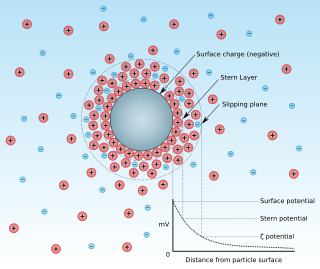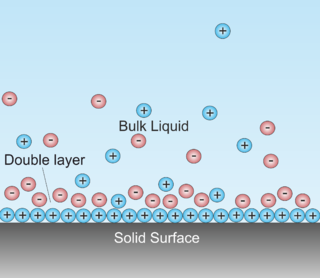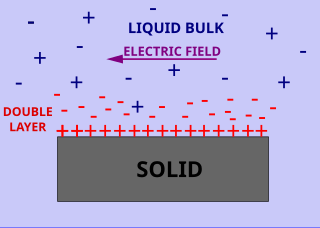Related Research Articles

Acoustical engineering is the branch of engineering dealing with sound and vibration. It includes the application of acoustics, the science of sound and vibration, in technology. Acoustical engineers are typically concerned with the design, analysis and control of sound.

Soundproofing is any means of impeding sound propagation. There are several basic ways to reduce sound: increasing the distance between source and receiver, decoupling, using noise barriers to reflect or absorb the energy of the sound waves, using damping structures such as sound baffles for absorption, or using active antinoise sound generators.

In chemistry, electrophoresis is the motion of charged dispersed particles or dissolved charged molecules relative to a fluid under the influence of a spatially uniform electric field. As a rule, these are zwitterions. Electrophoresis of positively charged particles or molecules (cations) is sometimes called cataphoresis, while electrophoresis of negatively charged particles or molecules (anions) is sometimes called anaphoresis.

Zeta potential is the electrical potential at the slipping plane. This plane is the interface which separates mobile fluid from fluid that remains attached to the surface.
A streaming current and streaming potential are two interrelated electrokinetic phenomena studied in the areas of surface chemistry and electrochemistry. They are an electric current or potential which originates when an electrolyte is driven by a pressure gradient through a channel or porous plug with charged walls.
Electroacoustic phenomena arise when ultrasound propagates through a fluid containing ions. The associated particle motion generates electric signals because ions have electric charge. This coupling between ultrasound and electric field is called electroacoustic phenomena. The fluid might be a simple Newtonian liquid, or complex heterogeneous dispersion, emulsion or even a porous body. There are several different electroacoustic effects depending on the nature of the fluid.
The Dukhin number is a dimensionless quantity that characterizes the contribution of the surface conductivity to various electrokinetic and electroacoustic effects, as well as to electrical conductivity and permittivity of fluid heterogeneous systems. The number was named after Stanislav and Andrei Dukhin.

In surface science, a double layer is a structure that appears on the surface of an object when it is exposed to a fluid. The object might be a solid particle, a gas bubble, a liquid droplet, or a porous body. The DL refers to two parallel layers of charge surrounding the object. The first layer, the surface charge, consists of ions which are adsorbed onto the object due to chemical interactions. The second layer is composed of ions attracted to the surface charge via the Coulomb force, electrically screening the first layer. This second layer is loosely associated with the object. It is made of free ions that move in the fluid under the influence of electric attraction and thermal motion rather than being firmly anchored. It is thus called the "diffuse layer".

Surface conductivity is an additional conductivity of an electrolyte in the vicinity of the charged interfaces. Surface and volume conductivity of liquids correspond to the electrically driven motion of ions in an electric field. A layer of counter ions of the opposite polarity to the surface charge exists close to the interface. It is formed due to attraction of counter-ions by the surface charges. This layer of higher ionic concentration is a part of the interfacial double layer. The concentration of the ions in this layer is higher as compared to the ionic strength of the liquid bulk. This leads to the higher electric conductivity of this layer.
Electrokinetic phenomena are a family of several different effects that occur in heterogeneous fluids, or in porous bodies filled with fluid, or in a fast flow over a flat surface. The term heterogeneous here means a fluid containing particles. Particles can be solid, liquid or gas bubbles with sizes on the scale of a micrometer or nanometer. There is a common source of all these effects—the so-called interfacial 'double layer' of charges. Influence of an external force on the diffuse layer generates tangential motion of a fluid with respect to an adjacent charged surface. This force might be electric, pressure gradient, concentration gradient, or gravity. In addition, the moving phase might be either continuous fluid or dispersed phase.

Interface and colloid science is an interdisciplinary intersection of branches of chemistry, physics, nanoscience and other fields dealing with colloids, heterogeneous systems consisting of a mechanical mixture of particles between 1 nm and 1000 nm dispersed in a continuous medium. A colloidal solution is a heterogeneous mixture in which the particle size of the substance is intermediate between a true solution and a suspension, i.e. between 1–1000 nm. Smoke from a fire is an example of a colloidal system in which tiny particles of solid float in air. Just like true solutions, colloidal particles are small and cannot be seen by the naked eye. They easily pass through filter paper. But colloidal particles are big enough to be blocked by parchment paper or animal membrane.

Colloid vibration current is an electroacoustic phenomenon that arises when ultrasound propagates through a fluid that contains ions and either solid particles or emulsion droplets.
Electric sonic amplitude or electroacoustic sonic amplitude is an electroacoustic phenomenon that is the reverse to colloid vibration current. It occurs in colloids, emulsions and other heterogeneous fluids under the influence of an oscillating electric field. This field moves particles relative to the liquid, which generates ultrasound.
The ion vibration current (IVI) and the associated ion vibration potential is an electric signal that arises when an acoustic wave propagates through a homogeneous fluid.
Sedimentation potential occurs when dispersed particles move under the influence of either gravity or centrifugation or electricity in a medium. This motion disrupts the equilibrium symmetry of the particle's double layer. While the particle moves, the ions in the electric double layer lag behind due to the liquid flow. This causes a slight displacement between the surface charge and the electric charge of the diffuse layer. As a result, the moving particle creates a dipole moment. The sum of all of the dipoles generates an electric field which is called sedimentation potential. It can be measured with an open electrical circuit, which is also called sedimentation current.
Ultrasound attenuation spectroscopy is a method for characterizing properties of fluids and dispersed particles. It is also known as acoustic spectroscopy.

Particle size is a notion introduced for comparing dimensions of solid particles, liquid particles (droplets), or gaseous particles (bubbles). The notion of particle size applies to particles in colloids, in ecology, in granular material, and to particles that form a granular material.
Colloid-facilitated transport designates a transport process by which colloidal particles serve as transport vector of diverse contaminants in the surface water and in underground water circulating in fissured rocks (limestone, sandstone, granite, ...). The transport of colloidal particles in surface soils and in the ground can also occur, depending on the soil structure, soil compaction, and the particles size, but the importance of colloidal transport was only given sufficient attention during the 1980 years. Radionuclides, heavy metals, and organic pollutants, easily sorb onto colloids suspended in water and that can easily act as contaminant carrier.
Electrodiffusiophoresis is a motion of particles dispersed in liquid induced by external homogeneous electric field, which makes it similar to electrophoresis.
Dispersion Technology Inc is a scientific instrument manufacturer located in Bedford Hills, New York. It was founded in 1996 by Philip Goetz and Dr. Andrei Dukhin. The company develops and sells analytical instruments intended for characterizing concentrated dispersions and emulsions, complying with the International Standards for acoustic particle sizing ISO 20998 and electroacoustic zeta potential measurement ISO 13099.
References
- ↑ Williams, Milton (1948). "An Electrokinetic Transducer". Review of Scientific Instruments. 19 (10). AIP Publishing: 640–646. doi:10.1063/1.1741068. ISSN 0034-6748. PMID 18888189.
- ↑ Dukhin, S.S.; Mischuk, N.A.; Kuz'Menko, B.B; Il'In, B.I. (1983). "Flow current and potential in a high-frequency acoustic field". Colloid J. 45 (5): 875–881.